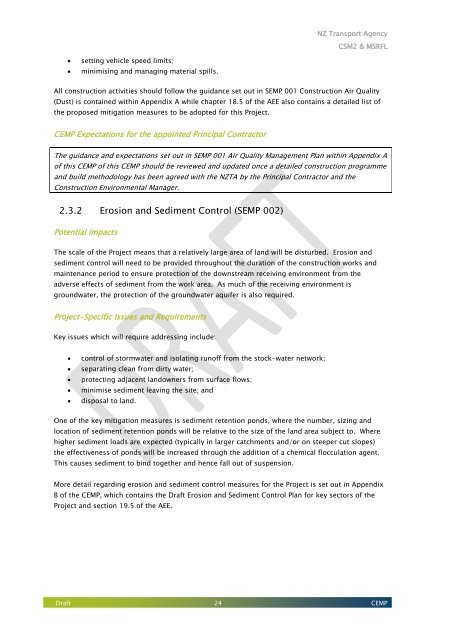CEMP - NZ Transport Agency
CEMP - NZ Transport Agency
CEMP - NZ Transport Agency
Create successful ePaper yourself
Turn your PDF publications into a flip-book with our unique Google optimized e-Paper software.
<strong>NZ</strong> <strong>Transport</strong> <strong>Agency</strong><br />
CSM2 & MSRFL<br />
• setting vehicle speed limits;<br />
• minimising and managing material spills.<br />
All construction activities should follow the guidance set out in SEMP 001 Construction Air Quality<br />
(Dust) is contained within Appendix A while chapter 18.5 of the AEE also contains a detailed list of<br />
the proposed mitigation measures to be adopted for this Project.<br />
<strong>CEMP</strong> Expectations for the appointed Principal Contractor<br />
The guidance and expectations set out in SEMP 001 Air Quality Management Plan within Appendix A<br />
of this <strong>CEMP</strong> of this <strong>CEMP</strong> should be reviewed and updated once a detailed construction programme<br />
and build methodology has been agreed with the <strong>NZ</strong>TA by the Principal Contractor and the<br />
Construction Environmental Manager.<br />
2.3.2 Erosion and Sediment Control (SEMP 002)<br />
Potential Impacts<br />
The scale of the Project means that a relatively large area of land will be disturbed. Erosion and<br />
sediment control will need to be provided throughout the duration of the construction works and<br />
maintenance period to ensure protection of the downstream receiving environment from the<br />
adverse effects of sediment from the work area. As much of the receiving environment is<br />
groundwater, the protection of the groundwater aquifer is also required.<br />
Project-Specific Issues and Requirements<br />
Key issues which will require addressing include:<br />
• control of stormwater and isolating runoff from the stock-water network;<br />
• separating clean from dirty water;<br />
• protecting adjacent landowners from surface flows;<br />
• minimise sediment leaving the site; and<br />
• disposal to land.<br />
One of the key mitigation measures is sediment retention ponds, where the number, sizing and<br />
location of sediment retention ponds will be relative to the size of the land area subject to. Where<br />
higher sediment loads are expected (typically in larger catchments and/or on steeper cut slopes)<br />
the effectiveness of ponds will be increased through the addition of a chemical flocculation agent.<br />
This causes sediment to bind together and hence fall out of suspension.<br />
More detail regarding erosion and sediment control measures for the Project is set out in Appendix<br />
B of the <strong>CEMP</strong>, which contains the Draft Erosion and Sediment Control Plan for key sectors of the<br />
Project and section 19.5 of the AEE.<br />
Draft 24 <strong>CEMP</strong>
















